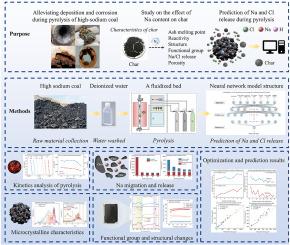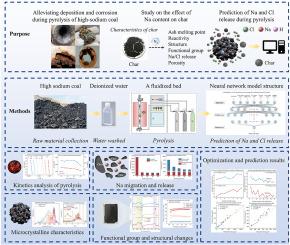水洗对沙尔湖煤热解的影响及神经网络模型预测钠、氯释放
IF 10
1区 环境科学与生态学
Q1 ENGINEERING, ENVIRONMENTAL
引用次数: 0
摘要
煤炭在全球能源消费中一直扮演着重要角色。随着优质煤储量的不断减少,低成本、丰富的高钠煤受到了人们的关注,但热利用过程中Na和Cl的释放可能导致设备腐蚀。研究了新疆高钠沙尔胡煤在流化床中的热解过程。结果表明,水洗显著降低了水溶性Na和Cl含量,水洗120 min后,水溶性Na和Cl含量分别降至764 μg∙g-1和698 μg∙g-1。与未洗煤相比,洗煤(WS)表现出更高的焦炭产量和灰分熔点,同时降低了焦炭的反应性和Na和Cl的释放。通过拉曼、XRD、FTIR表征,揭示了炭的石墨化、微晶结构和官能团随洗涤时间的变化。BET分析表明,WS炭的吸附和比表面积降低。用于预测热解过程中Na和Cl释放的神经网络模型的误差范围在5%以内。研究结果为高钠煤热解工艺优化提供了关键数据和理论支持。本文章由计算机程序翻译,如有差异,请以英文原文为准。


Effect of water washing on pyrolysis of Shaerhu coal and prediction of sodium and chloride release using neural network model
Coal consistently plays a major role in global energy consumption. With high-quality coal reserves dwindling, low-cost, abundant high-sodium coal has attracted attention despite challenges posed by Na and Cl release during thermal utilization, which can lead to equipment corrosion. This study investigated the pyrolysis of high-sodium Shaerhu coal (SEH) from Xinjiang in a fluidized bed. Results showed that water washing significantly reduces water-soluble Na and Cl, decreasing their content to 764 μg g−1 and 698 μg g−1, respectively, after 120 min. Compared to unwashed coal, washed coal (WS) demonstrates increased char yield and ash melting point, alongside reduced char reactivity and Na and Cl release. Characterization by Raman, XRD, and FTIR reveals changes in char's graphitization, microcrystalline structure, and functional groups with washing time. BET analysis indicates reduced adsorption and specific surface area in WS char. A neural network model developed for predicting Na and Cl release during pyrolysis achieved an error margin within 5 %. These findings provide critical data and theoretical support for optimizing the pyrolysis process of high-sodium coal.
求助全文
通过发布文献求助,成功后即可免费获取论文全文。
去求助
来源期刊

Journal of Cleaner Production
环境科学-工程:环境
CiteScore
20.40
自引率
9.00%
发文量
4720
审稿时长
111 days
期刊介绍:
The Journal of Cleaner Production is an international, transdisciplinary journal that addresses and discusses theoretical and practical Cleaner Production, Environmental, and Sustainability issues. It aims to help societies become more sustainable by focusing on the concept of 'Cleaner Production', which aims at preventing waste production and increasing efficiencies in energy, water, resources, and human capital use. The journal serves as a platform for corporations, governments, education institutions, regions, and societies to engage in discussions and research related to Cleaner Production, environmental, and sustainability practices.
 求助内容:
求助内容: 应助结果提醒方式:
应助结果提醒方式:


